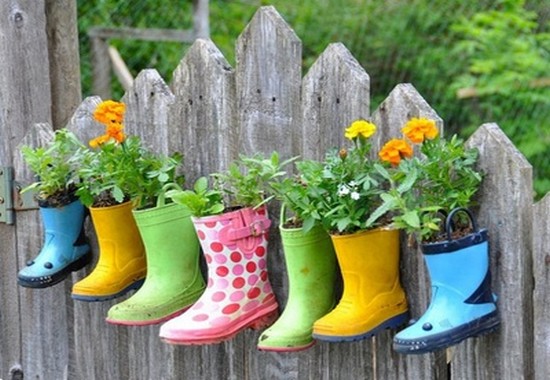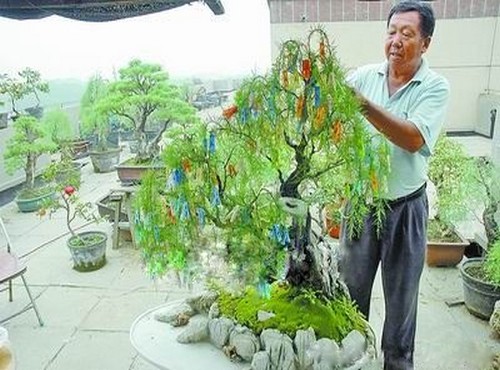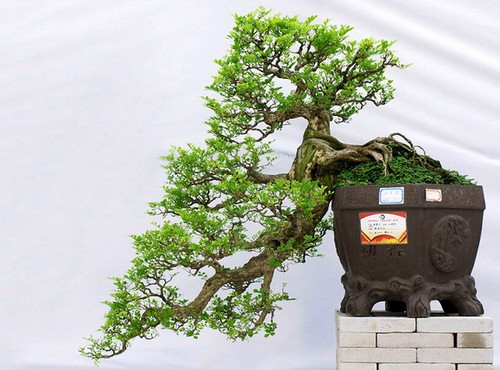Making creative bonsai with waste products from home
Living in the city, it is really not easy to have a green living environment. Since it is impossible to move into an ideal place that is more suitable for life for the time being, try to find a way to transform the small world where you now live. Today's 20 DIY tips will demonstrate how to use the waste at home to create a small garden full of ideas and creativity.

1. Reuse of scrapped fish tanks
Making fish tank plants is very simple. You only need to put a layer of glass beads on the bottom of the fish tank, then remove the succulent plants from the cheap glue basin and put them into the fish tank, and add some soil to fix them if necessary. Do you want to be more personal? After eating snow sticks, DIY can use the remaining sticks to decorate them.
2. The tin can turns into a small flowerpot
Do you occasionally buy canned things, such as paint, and throw them away after you use them? That would be a pity. In fact, as long as it is thoroughly washed, it can be used as a flowerpot to grow plants. However, for the sake of beauty, it is recommended to spend a little more time to transform the appearance of the jar. If possible, drill a hole in both sides of the jar. Then it will be more beautiful to wear it with a rope and hang it on the jar.
3. Old wardrobes become succulent paradise
If you are about to replace the drawer wardrobe at home, you can actually consider turning it into a small world of succulent plants if you have space. Drill a drain hole at the bottom of each drawer, then put a brick against the inside of the drawer in case the space on each floor is too large, then plant plants and bury the soil, and the ingenious succulent paradise like the one pictured above is complete!
4. Make ordinary flowerpots more Zakka-like
Isn't the flowerpot pretty? It doesn't matter. You can make a big change as soon as you get the burlap and hemp rope ready. Measure how wide the cloth is needed to completely cover the flowerpot, then cut the burlap cloth into a circle, wrap the flowerpot, and finally tie it with hemp rope!
5. The old disk is sent out again.
Such a flowerpot will feel very suitable for the home of a computer geek, glue four old disks into a bottomless box with a hot melt gun, and then trim the plant-planted plastic pot to the outer height so as not to expose the disk flowerpot and cause unsight. finally, put it into the disk flowerpot even if it is done.
6. Old books are skillfully used as flowerpots
I have seen such an idea at a wedding with the theme of succulent plants before, hollowing out the middle of the old hard-shell books, sealing them with glue, and then covering them with a layer of cling film to plant your favorite plants in this small space. succulent effect will be better.
7. Rain shoes become kaleidoscope
Do you know? In fact, the rain shoes you don't want can also be used as flowerpots. Compared with the just finished ones, because rain shoes have a certain depth, you can plant plants that need to take deep roots, such as flowers.
8. Old kitchen utensils should be new flowerpots
In addition to the rain shoes, in fact, some of the old kitchen utensils at home are also very suitable to be used as flowerpots, such as draining pots and kettles, which can be used directly, saving even the effort of transformation.
9. Decorate building materials to make flowerpots
Is there any flooring material left after the house has just been decorated? So take the time to make them into flowerpots. Four bricks are glued together and put in a plant, which is basically like an old-fashioned disk. Remember not to seal the bottom, or it will easily cause rotting roots when the water is too much.
10. Reuse of cork of red wine
After drinking the red wine, the remaining cork is actually a treasure. You can dig a hole like the picture above and plant a small plant inside. You can also collect 10 or 20 of them and fix them in the picture frame with hot glue. The top pin is used to hang jewelry. It can also replace the check-in book, sign in for guests attending weddings and other activities, and then seal it in a large glass message in a bottle as a souvenir.
11. The wonderful use of old shoe bags
After the old shoe bag is cleaned, it is actually a very good plant container, because it is breathable and permeable, and it does not miss the loss of soil, and there is a certain depth, so it is indeed a good way to reduce cost.
12. Milk cartons are used as flowerpots
Remove the top of the milk box, decorate the box with linen, fix the cloth with hot melt glue, put the plant in the carton with the original glue basin, and then decorate the vacancy with moss.
13. Put the plant in the tie
This idea needs to destroy a tie and compare the craftsmanship. Skillful friends can challenge it, but remember to be waterproof.
14. Potted plants in glass jars
The most ordinary glass bottles with metal lids are actually the most practical. Without any modification, they can be used as flowerpots directly, planting some edible herbs such as mint in them, and then putting them on the windowsill of the kitchen, which is both beautiful and useful.
15. Chandelier flowerpot
You didn't expect that, did you? Turn the unwanted chandelier into a flowerpot, it's beautiful, but it takes up a lot of space.
16. Hanging pot plant
This is really a test of craftsmanship. There are special requirements for plant varieties and containers, which are not particularly suitable for family use.
17. The wonderful use of eggs
Eggs are always available in most families, but have you ever thought that the eggshell is also a good flowerpot? Knock the egg open (don't knock too bad or open too wide, you can use a knife to help), pour out the yolk egg white, then wash it, put it back into the carton of the egg, pour it into the nutritious soil, then bury the seeds and water them regularly. Eggshell can also provide nutrients, so it is really not wasteful to use!
18. Wine bottles are used as vases
Usually there is a good-looking wine bottle left as a vase, hydroponic soil is suitable for planting, but because there is no drainage, so soil-grown plants should pay attention to control the amount of water when watering to avoid rotting roots. PS: it would be nice to hang it staggered.
19. Great transformation of cookie cans
Do you want to do some decoration on the quilt? Then this DIY idea would be a good choice.
20. Hanging plants
To make this "flowerpot", you will need moss, hemp rope, scissors, peat soil, cotton thread, etc., because it will leak, so it is best to put it outside.
Time: 2019-05-26 Click:
- Prev

The method of making Chinese wolfberry bonsai
Chinese wolfberry likes light, slightly shade-tolerant, drought-resistant, cold-resistant, loose on soil, barren, and can grow in stone crevices; neutral soil, calcareous soil and saline-alkali soil can all adapt. It is an indicator plant of calcareous soil and has strong tillering ability. Lycium barbarum is a semi-evergreen shrub with arched branches; if the root is like a snake, Qiu qu is colorful; autumn and winter
- Next

A Technique for Accelerating the Early Formation of Lingnan Bonsai--Bending and Joining
Cutting off the trunk and storing branches is the main artistic technique to create Lingnan bonsai. This kind of bonsai is mainly pruned and sawed to form a vigorous and natural, upright and bold tree type bonsai. It is the modeling result of Lingnan bonsai artists originating from nature and imitating nature for a long time. However, pruning requires patience and perseverance.
Related
- Fuxing push coffee new agricultural production and marketing class: lack of small-scale processing plants
- Jujube rice field leisure farm deep ploughing Yilan for five years to create a space for organic food and play
- Nongyu Farm-A trial of organic papaya for brave women with advanced technology
- Four points for attention in the prevention and control of diseases and insect pests of edible fungi
- How to add nutrient solution to Edible Fungi
- Is there any good way to control edible fungus mites?
- Open Inoculation Technology of Edible Fungi
- Is there any clever way to use fertilizer for edible fungus in winter?
- What agents are used to kill the pathogens of edible fungi in the mushroom shed?
- Rapid drying of Edible Fungi

